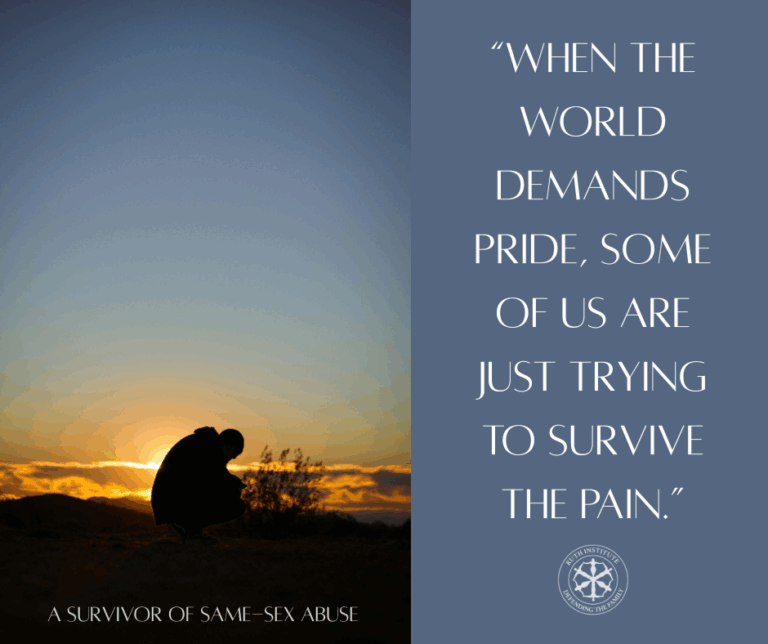A National Review Online Symposium,
June 27, 2015
After the Obergefell ruling, we can expect the following:
- Parenthood will no longer be considered a natural reality to be recorded by the government but the creation of the state for the benefit
of adults. - Some children will have a legally recognized right to know both of the parents. Other children will be blocked by the state from knowing
both parents. - Some children will have three or more people named as parents on their birth certificates.
- Parenthood by contract among interested parties will become legally enforceable by the states.
- Third-party reproduction will continue unregulated and unabated. By the time people figure out that this is a human-rights abuse, it
will be so widespread and entrenched that it will be extremely difficult to root out.
The Ruth Institute calls on the federal government and the governments of the states to enact the following measures:
- Record accurately the genetic parents on every birth certificate, for every child. The state should not be hiding or falsifying information
on legal documents. - End third-party reproduction.
- Place responsible limits on divorce where children are present and where no marital fault has been committed.
— Jennifer Roback Morse is the founder and president of the Ruth Institute, which brings hope and healing to the victims and survivors of the sexual revolution. She is the author, most recently, of The Sexual Revolution and Its Victims (2015). Morse taught economics at Yale University and George Mason University.
Gerard V. Bradley
Shortly after the climactic North African battle of El Alamein in late 1942, Winston Churchill cautioned his countrymen that it was “not the
end.” The great victory was “not even the beginning of the end.” Churchill declared that it was, perhaps, the “end of the beginning.”
So too today’s Obergefell decision. It is not the “end” of anything, save the limited but important transformation of marriage law, heralded
by the Court’s 2003 Lawrence decision, more literally commenced later that year by the Massachusetts Supreme Judicial Court, and now finally
consummated by five lawyers who happen to sit on our Supreme Court.
This transformation is itself the “beginning” of something much larger and more dangerous than same-sex, monogamish “marriages.” Yes, polygamy
is just around the corner. And Obergefell’s evident determination to, somehow, use the law to equalize the self-esteem (“dignity”) of adults
and children in all sorts of irregular groupings is at least Orwellian.
But this is not the half of it. As it has been so far described, one might imagine that there is a dyad involved, one consisting of the “state”
on one hand, and these diverse family-ish groupings — and that the rest of us just go about our business. Not so. The revolutionary mindset
that the Court has perhaps half-witlessly embraced means to eliminate all felt “stigma,” any trace of social “humiliation,” just so that everyone’s
“identity” is equally valued.
Doing all that requires a lot more than just a fair shakedown at the courthouse. It requires getting all of our minds right. And so we should
expect today’s decision to inaugurate the greatest crisis of religious liberty in American history. I am certain that it will.
— Gerard V. Bradley is Professor of Law at the University of Notre Dame.
Today’s Supreme Court ruling on marriage, by a single-vote margin (like the Massachusetts Supreme Judicial Court decision twelve years
ago that got the ball rolling), is long on sentiment — but short on compelling legal reasoning. As the Court has done with its previous
rulings on the abortion question, the justices will likely have multiple occasions to appeal to the populace to submit to the majority’s
prestige and line up behind the decision. Those appeals anent the abortion cases have been, fortunately, fruitless. Defenders of innocent
human life weigh their responsibilities to individual women, men, and unborn children, and to future generations, and give them greater
weight than honoring the good justices’ oracular status.
In the meantime (and the times may prove very mean indeed), marriage advocates must insist on the broadest First Amendment protections
possible. We can expect the macro-aggressions against our freedoms of belief, speech, political engagement, and social service work to
multiply rapidly. After Roe and Doe in 1973, bipartisan legislators enacted the Church Amendment and other federal measures to preserve
the conscience rights of dissidents against the decisions. The battle for similar protections now will be far more intense — and
just as consequential.
— Charles A. “Chuck” Donovan is the President of the Charlotte Lozier Institute.
In his dissent in today’s marriage cases, Chief Justice Roberts asks, “Just who [in the hell] do we think we are?” (Okay, I added the
parenthetical phrase, but it certainly fits the tone.) He questions the “legitimacy” of the Court’s decision, calling it an “extravagant
conception of judicial supremacy.”
Justice Scalia calls the majority decision “pretentious” and “egotistic,” an exercise of “hubris” that threatens the very authority
of the Court. Because the Court depends ultimately on the other branches even for enforcement of its judgments, he added, each decision
that it issues based on raw will rather than legal rule moves the Court “one step closer to being reminded of [its] impotence.” That
is as bold an invitation to noncompliance with a decision of the Court as has ever issued from the pen of a justice, approaching those
offered by Abraham Lincoln and Thomas Jefferson in their respective first inaugural addresses.
attempts to restrain this Court’s abuse of its authority have failed,” thereby suggesting that some kind of structural reform is
necessary to restore a proper sense of checks and balances.
So with those views in mind, it seems there are a couple of options open to those who not only disagree with the marriage ruling
but are profoundly concerned about the Court’s arrogation of power to itself to decide all manner of policy disputes. Noncompliance,
of the sort suggested by Justice Scalia and Presidents Lincoln and Jefferson before him. Quite frankly, though, the fallacy of
judicial supremacy is now so firmly rooted in our body politic that it would take a leader of Lincolnian wisdom and courage to
advance such a course with any credibility.
on demand across the country, is another option. That would involve electing a president (or, more likely, a series of presidents)
who would, through their nomination of Supreme Court justices, change the personnel and hence the outcome of today’s decision.
A third option, one that is also constitutionally envisioned, would be a constitutional amendment, originating either in Congress
or in the states. An amendment that defines marriage as it is in nature, an institution rooted in the biological complementarity
of men and women, would address the immediate consequence of today’s decision. But a structural amendment should also be considered,
something that would restore a check on what the Founders described as the least powerful but what has become the most dangerous
branch. Such an amendment might allow supermajorities of the states or of Congress to overturn erroneous decisions, or it might
revive the Constitution’s language that judges serve during “good behavior” rather than until they voluntarily resign, die,
or commit a “high crime and misdemeanor” necessary for impeachment.
forward on all fronts.
— John C. Eastman is the Henry Salvatori Professor of Law and Community Service, Chapman University Fowler School of Law, the founding director of the Claremont Institute’s Center for Constitutional Jurisprudence, and the chairman of the Board of the National Organization for Marriage. The views expressed here are of course his own.
Matthew J. Franck
Now what? First, accept nothing about this illegitimate ruling. It is Roe v. Wade redux, with even less pretended justification
in the simulacra of legal reasoning. The dissenters are right to liken Obergefell to Roe, to Lochner v. New York, and even
to Dred Scott, the first precedent for the fraudulent “substantive due process” Justice Kennedy employed.
feedback effect of politics on culture. The numbers of marriage defenders will grow smaller before they grow larger again. But grow again they
will, I am sure, as the harmful effects of the ruling come to be better understood, and the outrage against the Constitution begins to burn
hotter under the skin of a people who have long been proud to govern themselves.
Third, be imaginative in your response. Are there new ways in culture, in politics, in law, to strengthen marriage and the family even after
this setback? Are there institutional responses to an out-of-control judiciary that we have not thought of before? Both our society and our
constitutional order are resilient, and can recover from this blow if we are smart as well as brave and persistent.
— Matthew J. Franck is director of the William E. and Carol G. Simon Center on Religion and the Constitution at the Witherspoon Institute.
Richard Garnett
Today’s decision requiring states to license same-sex marriages is not a surprise, nor is the fact that Justice Kennedy wrote for a narrow
majority of five justices, nor is the fact that his prose is more florid than many lawyers (including lawyers who welcome the outcome) would
like. Now what?
“advocate” against the result in today’s decision, there will be strong pressure — social, political, and economic — in those states
that do not currently forbid employment, housing, and public-accommodation discrimination on sexual-orientation grounds. And it will be a close
and controversial question whether and to what extent religious institutions and employers will be exempt from such bans. Increasingly, public
contracts, grants, and funding will be conditioned on agreements by recipients (including religious ones) not to engage in such discrimination.
That said, all of this would have been true even had the decision come out the other way. The question is whether the majority’s reasoning
is heard as a call for compromise with those who hold the view that lost, or instead as a catalyst to marginalize and discourage that view
to the extent possible.
— Richard Garnett is a professor of law at the University of Notre Dame.
Mary Hasson
What’s next after Obergefell? Religious liberty is on shaky ground. Tax exemptions of religious institutions will be attacked if their policies
(employee benefits, married-student housing, etc.) do not recognize same-sex “married” couples. And while the Court (magnanimously) observed
that the First Amendment still protects the right of religions to “teach” and “advocate” for their beliefs, this language appears to shrink
religious freedom to the same space already occupied by free-speech claims. Further, though Justice Roberts noted wryly that there’s no “’Nobility
and Dignity’ Clause in the Constitution,” the current Court’s sympathy for “stories” of gay and lesbian hurt means we can expect other aggrieved
individuals also to tug at the Court’s heartstrings. Polyamorists want their “dignity” too.
of things.” Here is where our work lies, for this ruling upends the truth about “the nature of things.” Our children — in schools,
media, and government actions — will be inundated with lies about the new “nature of things,” that same-sex marriage is, well, just
the same. It’s up to us to speak the truth.
— Mary Rice Hasson is a fellow at the Ethics and Public Policy Center and editor of Promise and Challenge: Catholic Women Reflect on Feminism, Complementarity, and the Church.
Tom Hoopes
As a religious guy, the first thing we have to do is have faith, hope, and love: faith in God, hope for the future, and love for God —
and love for gay people.
doctrines, may continue to advocate with utmost, sincere conviction that, by divine precepts, same-sex marriage should not be condoned.”
And also: “The First Amendment ensures that religious organizations and persons are given proper protection as they seek to teach the
principles that are so fulfilling and so central to their lives and faiths, and to their own deep aspirations to continue the family
structure they have long revered.”
continue to ‘advocate’ and ‘teach’ their views of marriage. The First Amendment guarantees, however, the freedom to ‘exercise’
religion.”
Things are about to get dark for us.
I for one will never give up my belief that “marriage is as a marriage has always been, between a man and a woman,” as Hillary
Clinton put it in the year 2000.
Or that “marriage is something sanctified between a man and a woman,” as Barack Obama put it in 2004.
Amen.
— Tom Hoopes is writer in residence at Benedictine College, in Atchison, Kansas.
Jonathan Keim
Constitution, the Supreme Court ruled out ordinary processes of democratic change that typically provide protection for religious liberty.
Under the Court’s decision, the federal courts will determine the latitude given to those whose religious beliefs forbid them from conforming
to the ruling orthodoxy.
There remain some opportunities for democratic engagement, however. Americans now have a chance to protect the consensus favoring robust religious
liberty by preserving existing religious exemptions, strengthening others, and making their views known to public officials. Allowing others
to live their lives with a minimum of government interference — not forcing everyone to fit a single mold — is the best hope for
religious liberty. Outside the governmental sphere, they can also participate in a vigorous, respectful, and open debate that preserves the
openness and tolerance that make liberty possible. And in the future, presidential candidates should be much more careful about how they select
judges who rule from the bench for the rest of their natural lives.
— Jonathan Keim is counsel at the Judicial Crisis Network.
Justice Alito notes that the majority ruling relies on an “understanding of marriage” that “focuses almost entirely on the happiness of
persons who choose to marry,” denying the inherent link between marriage and procreation. This adult-centered approach to marriage developed
out of the sexual revolution, with no-fault divorce and contraception (including abortion as a “contraceptive” of last resort) as its intimate
bedfellows. These cultural changes paved the way for today’s decision; our response must address them at their root. We have to redouble
our efforts to teach sexual restraint and responsibility to the rising generation, and to pass on the truth about marriage: Marriage is
not just or even primarily about the emotional fulfillment of the spouses but rather about being united with another person in mind, heart,
and body, with an exclusive and lifelong commitment that includes openness to procreation and a firm resolve to persevere through the inevitable
ups and downs of married life. This vision of marriage involves sacrifice but is ultimately deeper, more beautiful, and more fulfilling
than its self-gratification-focused counterfeit. We also have to fight to retain our freedom to teach these truths to our children, with
robust protections for religious liberty and parental rights.
— Melissa Moschella is assistant professor of philosophy at the Catholic University of America.
C. C. Pecknold
Today Obergefell v. Hodges enters into the lexicon of American kulturkampf, every bit as divisive as Roe v. Wade, and inextricably tied
to it. The majority opinion limply and sentimentally argued “love can’t wait.” Yet what is most historic about today’s ruling is the four
dissenting opinions. Ironically, Chief Justice Roberts provides us with some of the most scathing criticisms of all. Roberts writes that
“the majority’s decision is an act of will, not legal judgment” and, further, that “the right it announces has no basis in the Constitution.”
Roberts cites Kennedy in a direct attack: “The Judiciary is the most vulnerable and comes nearest to illegitimacy when it . . . makes constitutional
law” out of whole cloth. Unlike most dissents in Supreme Court cases, the dissenting opinions in Obergefell quiver with outrage that the
majority opinion poses “a threat to American democracy.” Scalia perhaps best sums up the indignation over judicial usurpation: “Today’s
decree says my Ruler, and the Ruler of 320 million Americans . . . is a majority of the nine lawyers on the Supreme Court.” Today’s ruling
is tragic not just because it attempts to unravel the meaning of marriage in America but also because it initiates the unraveling of the
republic.
— C. C. Pecknold is associate professor of theology at the Catholic University of America.
John Stonestreet
First, we can be certain that this is not a settled issue — certainly no more than the Supreme Court settled the issue of abortion
with Roe v. Wade. The reason it cannot settle this is that, regardless of what judges say, reality still is what it is, and many people
still hold to deeply committed views about this reality — just as they continue to with what constitutes human life. Second, we can
recognize that this decision is the fruit of the very bad ideas of the sexual revolution. Every chapter of the sexual revolution has had
its victims. This chapter will, too. Particularly Christians, who believe in the inherent dignity of each and every person, have a long
history of reaching out and offering help to victims. We’ll have ample opportunities to do this again. Third, it’s more important than
ever for the mediating institutions of our day — the family, churches, and voluntary associations — to foster identity and
loyalties that counter the dominant cultural narrative. Their place in clarifying what reality is will have an increasingly important role
in the days to come.
— John Stonestreet is a speaker and fellow with the Chuck Colson Center for Christian Worldview and senior content adviser for Summit Ministries.
Hilary Towers
I think we’ve probably lost this cause as a matter of law. So now we focus primarily on changing the culture — one person, one married
couple, one family at a time. It’s more important than ever for those who value the conjugal view of marriage, I believe, to turn our full
attention to repairing the gaping hole in the bottom of the ship. The gaping hole consists of two core components of married life that
we (including, and perhaps most importantly, the Church) gave up for lost over the course of the past four or five decades — a misjudgment
that has led us directly to the court’s decision today. These are fidelity and permanence.
— Hilary Towers is a psychologist and mother of five.



